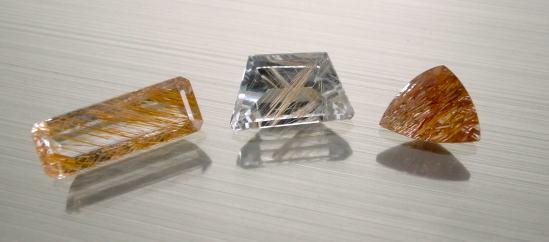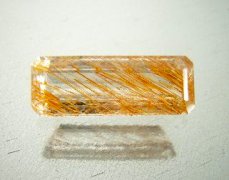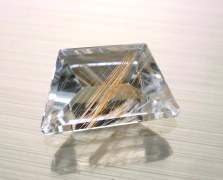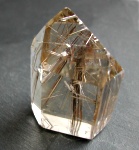 |
| ルチルのような包有物があるブラジルとスリランカのトパーズ (Topazes with rutile-like inclusion) |
ルチル・トパーズ ?
(The
Rutilated Topaz Misnomer)
 |
| ルチルのような包有物があるブラジルとスリランカのトパーズ (Topazes with rutile-like inclusion) |
 |
 |
 |
 |
| 9.72ct 20.75x6.60mm | 7.71ct 16.3x9.7mm | 4.12ct 12.8x10.1mm | ルースの表面に飛び出て いる金色の針鉄鉱 |
| Mina Bom Futuro, Rondonia, Brazil | Matale, Srilanka | ||
 |
 |
| ルチル入り水晶ルースとルチル入り水晶 Faceted rutilated quartz and polished rutilated quartz | |
ルチル(金紅石)の針状結晶を含む水晶は珍しくありません。本来は邪魔者の包有物を含みますが、却って美しい効果を見せるため、ルチル水晶は純粋な水晶とは比較にならないほど高い評価を得ています。 冒頭の写真はルチル水晶のように見えますが実は水晶ではなく、トパーズです。
アメリカの[Gems & Gemology]誌の1987年Summer号にルチル水晶のようなトパーズの記事が掲載されていました。以後、何とか同様のトパーズを手に入れたいと探していたのですが、一度も目にすることが無く20年近く経ってようやく手に入れたのが写真の7.71ctのルースです。長年追い求めてきた甲斐があって本物のルチルの針状結晶入りのスター・バースト水晶を偲ばせる見事なものです。ただし写真の下部に写っている影が示すように実際にはインクルージョンは右上から左斜め下へ一束入っているのみです。カットされた背面の鏡のようなパビリオン面で反射と屈折とが繰り返されて華やかな効果を示しています。
Quartz crystals with rutile inclusions are commonly discovered and are much highly appreciated than pure crystals. Photos in the left looks like rutilated quartz but actualy they are topaz. "Gems & Gemology 1987 Summer", desribed an article of topaz with rutile inclusion.
Since then, I have been looking for that one and finally found a 7.71ct stone after almost 20 years. Star-burst of this stone is actually a result of reflections thanks to the mirror effects of pavillion faces, as shown with the shadow beneath the stone.
やれやれとG&G誌の1987Summer をじっくり読もうとページを開いたところ、、タイトルが"誤って命名されたルチル入りトパーズ”とあるのに気が付きました。 あっ!と思って読み出すと”ルチルがトパーズにリボン状のインクルージョンとして含まれる例は知られていない”とあります。即ちインクルージョンの正体はルチルではなく、ルチル・トパーズと呼ぶのは誤りであると言うことです。当時はG&G誌のバックナンバーを創刊号からまとめて数十冊入手したばかりでした。したがって写真だけ眺めて大急ぎで読み飛ばしていたために、これがルチル・トパーズと思い込んでいました。
When I opened the page of G&G 1987 Summer in order to read again about this topaz, I noticed that the article is titled "The Rutilated Topaz Misnomer" and an sentence "Rutile is not known to crystallize in topaz in a ribbon-like habit that would produce such a directionally dependent effect". This means that inclusion is not rutil and rutilated topaz is a misnomer.
ではインクルージョンの正体は ? 結論を先に言えばこれはエッチ・チャンネルと呼ばれる、トパーズの結晶の薄い管状欠陥の空洞の一部或いは全体に入り込んだ微細な褐鉄鉱(針鉄鉱)の金色の錆が水晶内のルチルと同じように見えるものなのです。
一般に褐鉄鉱(針鉄鉱)は暗褐色ですが、不純物を含まず鮮度の高い結晶は金色です。左の写真は神岡鉱山の鉱脈の空隙に微細な針状結晶として出来た針鉄鉱です。結晶の長さは0.8mm
photo : 0.8mm golden goethite crystal grown in a cabity
Kamioka mine, Gifu, Japan
What is the inclusion ? The conclusion is that it is a golden limonitic stains filling, or partially filling , ribbon-thin etched dislocation channels in the topazes created the rutile-like effects.
トパーズの産地 (Exact locality of topaz)
このトパーズは単にブラジル産と称されるだけで、正確な山地は永年不明でした。最近別のルートで入手した天然の青いトパーズと同じ、ロンドニア州のボリビア国境に近いBom Futuro鉱山の特産であると判明しました。この鉱山は世界最大級の錫鉱山ということです。
トパーズと針鉄鉱はいずれも比較的にありふれた鉱物ですが、ルチルのような包有物を含むトパーズは何故か滅多に産出せず、ブラジル、ロンドニアの錫鉱山が唯一の産地でしたが、2011年末にスリランカのマタレ産が姿を見せました。たった一つだけですが、ブラジル産と全く同じ様に、金色の針鉄鉱がルースの表面まで飛び出しています。余りにも包有物が多すぎて美しさが損なわれていますが、滅多にお目にかかれないトパーズの新しい産地からの貴重な標本です。
This topaz was said to come from Brazil and the exact locality has long been unknown. Recently, I happned to obtain a natural color blue topaz from Bom Futuro Mine, near Bolivian Border of Rondonia State, Brazil and knew that rutilated quartz-like topaz was from the same mine.
Although, both topaz and goethite are common minerals, topaze included with goethite is extremely rare and Bom Futuro mine, Rondonia, brazil is the only known locality. But finally in late 2011, a golden goethite included topaz came into the market from Matale, Srilanka.
ルチル・トパーズとして流通しているのも止むを得ないかと思われるほどに、これらのトパーズはルチル水晶とそっくりの外観を示します。また顕微鏡による観察も拡大しただけでは一見ルチルを思わせます。
ところが詳しく観察するとこれらが実はルチルの結晶ではないことが4つの特徴から明らかになります ;
まずこれらのインクルージョンが極めて薄いリボン状で角度を変えると見えなくなってしまうほどです。ルチルの針状結晶ではこのような薄膜状にはなりません。さらにチューブ内に空隙が見えます。またチューブの一部にはイリデッセンス効果が見て取れます。これらもルチルの結晶であればこのような空隙や色合いの濃淡が起こり得ません。
また全てのインクルージョンが結晶表面に達している事実も、これが内包されたルチル結晶ではなく、外部から入り込んだ不純物の錆であることを示唆しています。
Acicular crystals of rutile are relatively common in rock crystal, so much so that quartz containing such inclusions is usally called rutilated quartz. A small number of facetted colorless topazes containing what look like brownish yellow needles of rutile appears in the market. Because they are so similar in appearance to rutilated quartz, these topazes are marketed under the name "rutilated topaz".
Even with microscopic observation, these inclusions in topaz could easily be mistaken as topaz.
However, a more thorough examination reveales four features that, together with the nearly two-dimentional acicular habit, proved conclusively that these inclusions are not rutile; The incomplete filling of the inclusions. Thin film iridescence from some of the unstained areas along the etch channels shows that discontinuous nature of the inclusions. It is also observed that wherever these inclusions reached the surface, there was undercutting in the form of grooved of drag lines extending and tapering away from the inclusions in the direction of polishing. These are not the type of surface markings expected whe slightly softer solid inclusions such as rutile, captured in a harder host material such as topaz, are cut through and polished over during lapidary treatment.
トパーズにルチル結晶が入らない理由
(Why rutile is never included in topaz ? )
鉱物の結晶中には様々な鉱物の結晶が包有物として含まれます。とりわけ水晶には多彩な鉱物の結晶が含まれますが、これは水晶が370℃以下〜常温という非常に低い温度で結晶するためです。即ち初めは高温高圧で様々な元素を含む熱水液の温度と圧力が下がるにつれて、まず高温高圧下で結晶する鉱物が次々に結晶して行きます。それらの鉱物結晶は晶洞の壁にくっついたり、或いは熱水液中を漂っています。そして熱水の温度と圧力が下がり、溶けていた多くの元素が消費された後に最後に残された酸素と珪素成分とが水晶として結晶し始めますが、この時に熱水中を漂っている他の鉱物結晶を取り込むために水晶には多彩な鉱物が発見されることになります。ルチル(2酸化チタン)の熱水中での結晶条件についての資料がありませんが、少なくとも水晶の結晶条件よりは高い温度と圧力であることは間違いありません。
トパーズの結晶条件については、ロシア・チェルノゴルフカにある鉱物研究所にて合成結晶の第一人者であるヴァリツキー等による唯一のトパーズ合成の試みが2000年に報告されています。それによると、およそ100ccのクロムーニッケル合金のオートクレーヴ中でpH1−2の強塩酸溶液中に天然のトパーズと水晶の破片を入れて、温度が500℃〜800℃で、圧力が20−200MPa(メガパスカル :200−2000気圧)にて20−30日間にてトパーズの種結晶の周囲に厚さが2.5−4mm、幅8−15mm、長さが20.1-40.8mm、重さが最大20gのトパーズの結晶の成長に成功しました。結晶の半分を占める種結晶の周囲を合成トパーズが覆っている結晶でした。
この結果から、ルチルの結晶条件はトパーズよりは低温で水晶よりは高温であると推定されます。即ち、高温、高圧で先に結晶しているトパーズ結晶内に、低温、低圧下で後から結晶するルチルが取り込まれることは有得ません。
We encounter many mineral crystals included in minerals. Especially, quartz crystals are known to include varieties of mineral crystals. This is because quartz crystalizes at lower pressure and temperature than most of minerals. This explains the crystalization process of minerals in hydrothermal fluids ; While hot and high pressured hydrotherml fluids containing various elements are cooling down, first, minerals with higher temperature and pressure start to crystalize, one after another, which sticks to pocket walls or floating in the fluids. And finally after almost all elements are consumed to crystalize minerals, the remaining oxigen and silicon starts to crystalize as quartz, trapping the floating mineral crystals. Although no literature is found about rutile crystalization conditions, it should be higher than that of quartz.
Regarding topaz crystal, Gems & Gemology reported (Winter 2001 PP339-341) at the Institute of Experimental Mineralogy in Chernogolovka, Russia by Balitsky etc. in early 2000.
The hydrothermal growth method used a supercritical fluoride-bearing aqueous fluid under conditions of a direct thermal gradient. The growth ecperiments were carried out at temperature of 500℃-800℃ and pressure of 20-200Mpa, using an autoclave made from a heat-resistant Cr-Ni alloy with a volume of 100cm³, filled with a mixture of equal quantities of crushed natural quartz and topaz and with suspended topaz seed. The duration of the experimental runs was 20 and 30 days. Light gray to near colorless single crystal of synthetic topaz were grown in dimensions ranging from 2.5 to 4.0mm thick, 20.1 to 40.8mm long, and 8.0 to 15.0mm wide; they weighed up to 20g. About half of each crystal consisted of the seed, with half formed by the synthetic topaz overgrowth.
This results indicates the conditions of rutile crystals lies between that of topaz and quartz.
Gem Hall Top